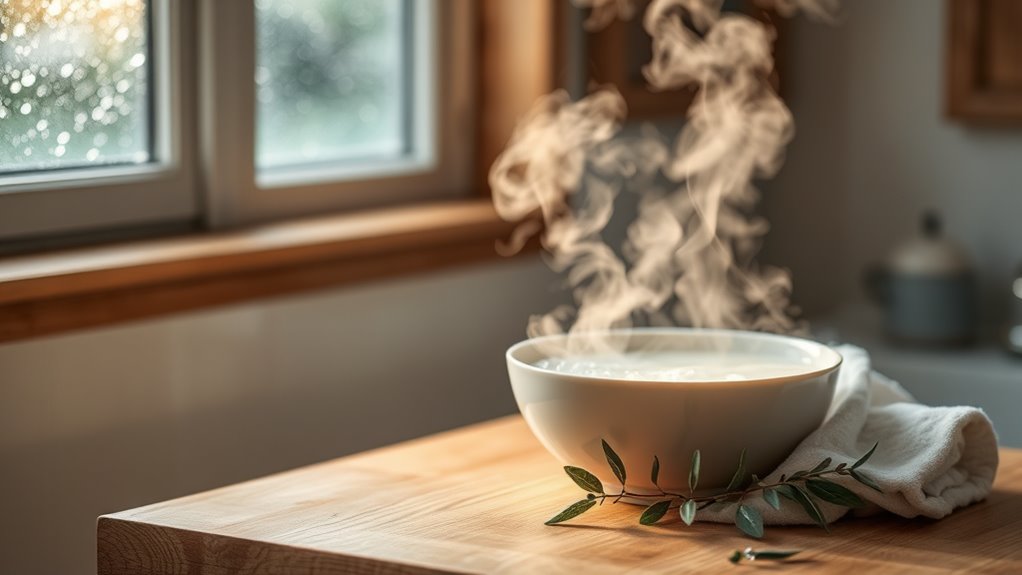No Pills Needed- Try This Steam Inhalation for Cold Relief
When you catch a cold, you may reach for over-the-counter medications, but there’s an effective alternative that doesn’t require any pills. Steam inhalation can provide immediate relief by soothing your nasal passages and lungs. This natural remedy is not only simple but can be enhanced with essential oils, offering a comforting way to alleviate congestion. Want to learn how to perform steam inhalation safely and effectively? Let’s explore the essential techniques and tips.
Understanding Steam Inhalation and Its Benefits
Steam inhalation is a time-tested remedy that many people turn to for cold relief. This method uses warm, moist air to soothe inflammation in your nasal passages and lungs, helping you breathe easier.
When you engage in steam therapy, the heat can loosen mucus, relieving congestion and making it easier to expel. Research shows that steam can also provide temporary relief from sore throat discomfort caused by post-nasal drip.
Plus, the warm vapor may help you relax, providing some much-needed comfort during cold symptoms. It’s a simple, drug-free approach that anyone can try at home.
Just remember, while steam therapy can be beneficial, it’s important to stay safe and avoid burns by keeping your distance from the hot steam source.
Essential Ingredients for Effective Steam Inhalation
To maximize the benefits of steam inhalation, it’s vital to understand its basics and select the right ingredients.
Using essential oils, like eucalyptus or peppermint, can enhance your experience and provide additional relief. These oils contain evidence-based properties that can help reduce congestion and improve overall respiratory function.
Let’s explore how these elements work together to help you breathe easier.
Steam Inhalation Basics
When you’re looking to relieve a cold, the right ingredients can make your steam inhalation more effective. Start with hot water as your base; it’s essential for creating the steam you need.
Adding salt can help soothe irritated airways, promoting easier breathing. Consider using herbal components, like chamomile or peppermint, which can provide additional calming effects. These natural ingredients can aid in reducing inflammation.
Make sure your setup allows comfortable inhalation—using a towel to create a tent over your head can trap steam efficiently. Always be cautious with water temperature to avoid burns, and limit steam sessions to about 10-15 minutes for safety.
With the right ingredients and approach, you can maximize your cold relief experience.
Recommended Essential Oils
Incorporating essential oils into your steam inhalation routine can significantly enhance its effectiveness. Eucalyptus oil is a standout choice; its strong menthol scent helps open your airways and reduces congestion.
You might also consider peppermint oil for its cooling sensation and potential to relieve sinus headaches. Lavender oil offers calming properties, which can ease stress while promoting better sleep during illness.
Tea tree oil is known for its antimicrobial effects, potentially killing airborne bacteria and viruses. Lastly, lemon oil brightens the scent and adds additional antibacterial benefits.
Just remember to add a few drops of your selected oil to steaming water. Enjoy the soothing experience these essential oils provide as you breathe in their therapeutic properties.
Step-by-Step Guide to Performing Steam Inhalation
Steam inhalation can be an effective and soothing method for relieving cold symptoms. Start by boiling water in a pot, then remove it from heat.
Carefully add a few drops of your chosen essential oil if desired, enhancing the therapeutic effects. Place a large towel over your head and the pot to trap the steam, creating a tent.
Lean over the pot, keeping your face about 12 inches from the surface. Close your eyes and breathe deeply through your nose for 10-15 minutes. If it feels too hot, take breaks to avoid discomfort.
Repeat this process 2-3 times a day as needed. You’ll notice improved nasal congestion and easier breathing—all in the comfort of your home!
Safety Tips for Inhalation Practices
When practicing steam inhalation, it’s crucial to use the right equipment to ensure effectiveness and safety.
Always maintain a safe distance from the steam source to avoid burns, and remember to hydrate well during the process.
These simple steps can help you reap the benefits of steam inhalation while minimizing risks.
Proper Equipment Usage
To safely enjoy the benefits of steam inhalation, it’s crucial to use the right equipment and follow a few essential safety tips.
First, choose a clean bowl that’s deep enough to hold hot water without spilling. A large towel or blanket can help trap steam, increasing its effectiveness. Use distilled or purified water to avoid contaminants that could irritate your airways.
Always check the temperature before inhaling—scalding hot water can cause burns, so let it cool slightly first. If you’re using essential oils, opt for those known for their soothing properties and avoid excessive amounts.
Lastly, keep your inhalation sessions to about 10-15 minutes to prevent discomfort and ensure safety. Following these tips helps maximize your steam inhalation experience effectively.
Maintain Safe Distance
Maintaining a safe distance during steam inhalation is key to ensuring a comfortable and effective experience. Here’s how to balance proximity and safety:
| Distance | Safety Tips |
|---|---|
| 6-12 inches | This distance allows warmth without burning. |
| 12-18 inches | Ideal for those sensitive to heat; reduces discomfort. |
| Above 18 inches | Steam loses effectiveness; adjust your setup. |
Keep your face above the steam source to prevent burns. Use a towel around your head to create a tent if needed, but avoid leaning too close. By being mindful of your distance, you’ll enjoy the benefits of steam inhalation while staying safe and comfortable.
Hydration Importance
Staying properly hydrated is essential for maximizing the benefits of steam inhalation and ensuring your safety during the practice. When you inhale steam, it helps to loosen mucus and clear airways, but if you’re dehydrated, your throat and nasal passages can become even more irritated.
Make sure to drink plenty of fluids before and after your session. Opt for water, herbal teas, or broths—these options enhance hydration and provide additional soothing effects.
Avoid caffeinated or alcoholic beverages, as they may lead to further dehydration. Remember, being well-hydrated not only enhances your inhalation experience but also supports your body’s immune response, helping you recover faster from a cold.
Additional Remedies to Complement Steam Therapy
While steam therapy effectively alleviates cold symptoms, you can enhance your relief by incorporating additional remedies into your routine.
Consider adding essential oils like eucalyptus or peppermint to your steam inhalation for their decongestant properties. Drinking warm herbal teas, especially ginger or chamomile, can soothe your throat and help you relax.
Honey is also a great addition; it not only sweetens your tea but has antimicrobial properties, helping fight infection. Gargling warm saltwater can ease a sore throat as well.
Finally, don’t underestimate the power of rest; giving your body time to heal speeds up recovery. Additionally, natural remedies like garlic can provide immune support and further aid your recovery.
When to Seek Medical Attention
How can you tell when a cold requires more than just home remedies? If you experience persistent symptoms lasting more than ten days, you should consider seeking medical attention.
Additionally, if you develop high fever over 101.5°F, severe headache, or facial pain, it might indicate a sinus infection or other complications.
Don’t ignore difficulty breathing, chest pain, or wheezing, as these could signal more serious respiratory issues.
If your cough worsens or produces green or bloody mucus, it’s time to consult a healthcare professional.
Lastly, be cautious if you have a weakened immune system or chronic conditions, as you might be at higher risk for complications. Natural remedies can help alleviate symptoms, but knowing when to seek help is crucial for your health.




